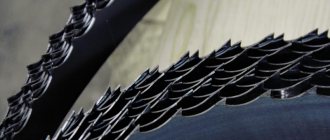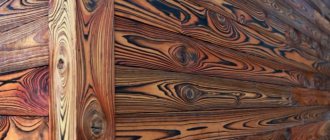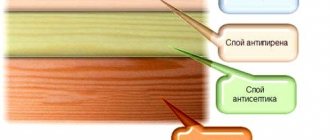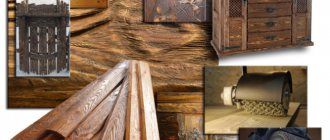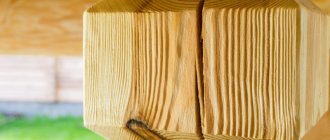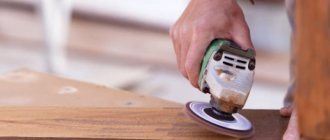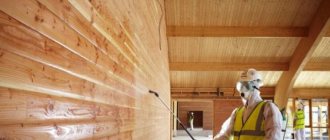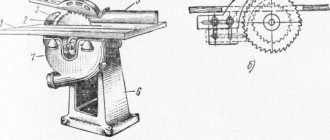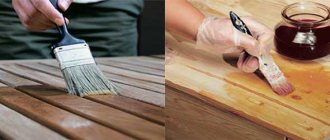Furniture and items made from old wood can be surprisingly attractive. But for the material to age naturally, many years must pass. You can significantly speed up this process if you use artificial aging technology - wood brushing. Let's look at how wood is aged, what types of wood are suitable for this, and what tools are used.
Brushed wood cannot be distinguished from truly old wood Source rubankom.com
What is wood brushing
Brushing is a technology for aging wood artificially. Using special tools, a relief surface is created, on which the growth rings become clearly visible. This creates the desired effect, the wood looks like old wood that has served for many years.
Anyone who is interested in what wood brushing is will know that the term comes from the word brush, which means “brush” in English. This is the tool that is used to remove soft fibers from the surface of wood. They form in a living tree in the spring, when its active growth begins.
The fibers are loose in structure, which is why they are more susceptible to abrasion than the hard rings that form in summer and autumn. This is how wood naturally ages, but it happens very slowly over many years. The purpose of brushing is to greatly speed up the process by removing soft fibers with a wire brush.
Furniture made from aged wood that can also be placed in a modern home Source happymodern.ru
A couple of antique wood recipes
You can find many recipes for aging wood using improvised means, but all of them are derivatives of the processing methods already described. Let's look at some of them.
Using wax
Using regular wax you can achieve a good effect; you only need 2 types of wax (colored and regular), as well as a wood sanding machine. This method is convenient because it does not require additional steps such as brushing the wood or using acid to remove soft parts of the wood.
The technology for doing the work will look like this:
- first the board is sanded, and the direction is strictly along the grain;
- then colored wax is applied; at the previous stage, the pores of the wood have opened, so it will penetrate well. It takes about a day for the coating to harden;
- Next, you will have to apply colorless wax on top of the colored one, and some of the colored wax will inevitably be removed.
An example of wood processing with colored wax
Bleached wood
Bleached wood will look unusual in any interior. It costs a lot, but you can achieve the same effect with your own hands when painting wood. The main task in this case is to ensure that the white color does not completely “clog” the texture of the wood; ideally, the wood should have a slightly grayish tint and the wood pattern should be visible through the layer of white paint.
Bleached wood
You can get the desired effect using brushing technology, and the key point will be how to paint an antique board so that the wood pattern remains noticeable after painting.
To do this, you can use tinted and transparent varnishes, and painting will be carried out in several stages:
- if the wood is dense and does not absorb varnish well, then you can immediately treat the prepared surface with tinted varnish in a couple of layers;
- then a clear varnish is applied over it to protect the tint.
Tinted varnish from a renowned manufacturer
The same effect can be achieved using white paint, but here you need to take into account that it is easy to paint over the wood pattern 100%. Therefore, after applying the paint, you can carefully blot it with a sponge so that the texture of the board becomes visible.
What wood is suitable for brushing?
For brushing, you need to choose wood from trees of soft and medium hardness and with a structure that makes the growth rings clearly visible. Aged wood comes well from conifers: spruce, larch, pine, cedar and fir, as well as linden, aspen, willow, chestnut and alder.
On boards made of oak, walnut, birch, rowan, ash, you can also get the desired effect, but it will be less pronounced. It is more difficult or completely impossible to age wood from acacia, maple, yew, beech, teak, and pear. Brushing technology is ineffective for trees of tropical origin. They have practically no growth rings due to the climate.
In addition to boards, you can carefully brush veneered boards and lining. The small depth of immersion of the brush allows you not to destroy the surface, but to give expressiveness to the design.
This is what brushed lining looks like Source 1povagonke.ru
Vibration grinder
Vibration grinder
Sanding pad
Another name is surface grinding
car. The working unit of this tool is a rectangular base on which a sheet of sandpaper is attached. Grinding and polishing is carried out by fast back-and-forth movements of the sole (about 20,000 vibrations per minute (333.3 Hz) with an amplitude of about 2 mm). The most common two methods of attaching sandpaper are:
- Using a pressing mechanism on both sides of the sole.
- Using Velcro - the paper is simply applied with its base to the sole, which has this feature.
The sanding sheet and pad have several holes to drain dust from the work area into a dust container or vacuum cleaner. The main purpose is grinding and polishing.
Delta grinder
It is a type of vibration grinding machine. The delta sander is distinguished by a delta-shaped (triangular, like an iron) sole shape, which allows you to work in hard-to-reach places - in corners, among protrusions and other similar places. The universal cutter can perform the functions of a delta sander when installing the appropriate equipment (a triangular sole with a sticky base) and a sanding sheet).
Brushing tools
There are several ways to age wood. You can artificially age wood using:
- Hand tools. This is the simplest, but also the most labor-intensive method; its downside is that the process takes a lot of time. To perform brushing, a brush with stiff metal bristles is used. With the manual method, the depth is small, which must be taken into account when choosing wood for processing. This method is well suited for the production of single parts of small size.
- Electromechanical tool. This method is the most common, accessible and productive. It is universal, as it can be used not only in production, but also at home. Brushing is carried out using special machines or using a drill or grinder with brush attachments attached to them.
- Stankov. Wood is brushed on machines only in production conditions. They are designed for mass production of parts. The machine provides a full processing cycle; 3 brushes are used alternately: metal, removing fibers, grinding and polishing.
The choice of one or the other is influenced by the characteristics of the workpieces and the amount of work.
Grinder for brushing Source ad-cd.net
See also: Catalog of round log house projects
Other original aging methods
Naturally, the list of answers to the question of how to age wood does not end there, since representatives of creative professions related to works of art contributed. One of the well-known methods has already been discussed: this is patination, which allows you to give the products an antique look. However, there are other options - both simple and complex. In this case, the effect is achieved by experimenting with a decorative coating, and not with wood: it remains in its “pristine form.”
Crackle (craquelure)
This is the most effective way to get not only an “ancient” tree, but also to change any material beyond recognition. Crackle is a method of creating a web of cracks on the surface of objects. The set for such creativity is quite modest. It includes PVA glue, paints of two shades (acrylic or facade) and a hair dryer. There is a special varnish (primer, paste) for craquelure, but here we will only talk about the folk recipe for cobwebs.
- First, the surface is covered with dark-colored paint, then wait for it to dry completely.
- Apply the next layer: this time it is PVA, and there should be a lot of it. But one condition must be fulfilled: the layer must be thick but uniform.
- To speed up the process, the glue is treated with a hair dryer so that a thin dried film forms on the surface. Complete drying at this stage is not only not required, but it is harmful because it will not allow you to achieve the desired effect.
After obtaining the PVA crust, a layer of lighter paint is applied to the surface, which is also left to dry on its own. Then the glue is applied again in a thick layer. The last step is to dry the surface until the PVA film begins to crack. Thus, cobwebs will begin to appear on the surface, which is the best proof of the age of the product.
If traditional “wooden colors” are not used for objects, then you can swap the shades: first apply light paint, and then dark composition (contrasting).
Dry brush
This method was invented by artists, but now it is actively used by decorators who successfully use the dry version for “forced” aging of wood products. The work requires a minimum set - paint, a wide but thin synthetic brush and sheets of thick paper, which is necessary to rid it of excess mixture.
- Use a brush to pick up a small amount of paint, then move it across the paper until the tool begins to leave thin lines on the sheet.
- Then, with a brush, stripes are drawn along the growth of the fibers. Here, order is also contraindicated: the best results are guaranteed by erratic movements.
It should be noted that the “Dry Brush” operation is optimal for aging furniture or other products with convex elements.
Spray
These are droplets that age the product in a chaotic manner. This creates the image of an antique item that has passed through decades.
The spray looks nice and is textured to the touch. It leaves an impression of antiquity; a product with such decor brings coziness to the house. For processing you will need: a hard brush or toothbrush, paints, a glass of water.
Wood aging technology:
- Wet the brush and pick up some paint.
- Perform a test spray on a white surface to determine the droplet size. To do this, run your finger or a toothpick along the bristles of the brush.
- If the brush is wide, then you can simply tap on it and the drops will fall.
- The product should be placed on paper, which can then be thrown away so as not to spoil the table.
- Spray the product and wait until it dries completely.
- Cover with varnish. If there is a desire to achieve a three-dimensional effect of antiquity, the drops are sprayed in a second layer on top of the varnish. They will not look so bright, but they will age with a double layer of drops.
Spraying is combined with other techniques for aging.
Glaze
This is the application of two or more layers of paint, the first of which is brighter, and the subsequent ones are translucent. The advantage of this method is that it produces a non-uniform, iridescent, changeable surface. For such aging, you can use different types of paints. The largest assortment of colors is distinguished by acrylic compositions, watercolors and oils are a little more modest. Even strong tea leaves can serve as a “decorator”. Any wood can be processed. For glazing, use either a sponge or a synthetic brush.
The first layer is applied unevenly, trying to achieve the natural shade of the wood. If this does not work, then add another thin layer. After the operation is completed, the product is left to dry completely. When several tones are applied, they create an interesting translucent effect.
How does brushing work?
The wood brushing process consists of 3 successive stages. Each of them uses brushes made of different materials. Processing always goes along the fibers.
Brushing sequence:
- Treating the wood surface with a brush with metal (steel or brass) bristles. It effectively cuts and removes soft fibers, resulting in a textured relief on the surface.
- Sanding wood with a brush with nylon bristles coated with abrasive. The treatment removes damaged fibers, smooths out sharp edges and cleans out lint in recesses.
- Polishing with a soft sisal bristle brush. This stage completes the brushing of the wood and gives the product its final look.
The speed of fiber removal, relief depth and processing performance depend on the stiffness of the bristles of the metal brush. Therefore, for boards or workpieces made of hard wood, you need to choose stiffer brushes.
Wood surface after brushing Source www.comfortclub.ru
Other brushing methods
In addition to the main one, there is another industrial, but less popular way to age wood. This is sandblasting, in which brushing is carried out not with brushes, but with a jet of sand supplied under pressure. It is possible to obtain a deep relief with soft differences, without additional sanding.
Wood is also aged chemically, using strong acids or alkalis, ammonia, which can corrode cellulose. This method is used either on its own or as a first step prior to processing with metal brushes.
To age the wood and give it an original look, special firing is used. The material is scorched with a blowtorch or gas torch, the charred layer is moistened with water, then cleaned with a brush, removing all excess, and the surface is impregnated with oil or varnish to complete the processing.
Burnt and brushed wood Source 7dach.ru
See also: Catalog of companies that specialize in garden furniture and facade materials
The evolution of artificial aging
Years change, technologies change, but the craving for antique accessories and utensils remains unchanged.
Now everyone can afford the luxury of living in an old Russian mansion, with cracked, seemingly shabby walls and beams, furniture from those times, wooden benches and a dining table made of natural aged wood. And all this thanks to the wood brushing process. We constantly feel a craving for something new, observing the natural, natural processes of aging wood, the visual end result, the demand for such items, people decided to achieve a faster process of extinction of the life of wood and invented their own technology of artificial aging with a fairly short period of time.
Mechanical aging of wood
This method is usually called brushing or texturing wood. The name comes from the English language, where the word “brush” means “brush”.
It is known that the structure of wood has soft and hard fibers. If you remove soft fibers with a brush, the surface becomes embossed.
Only tree species with an easily processed structure are processed mechanically: walnut, oak, spruce, pine, larch. Texturing does not work for maple, cherry, or beech.
Wood processing is carried out with two brushes:
- Brass wire brush - breaks soft fibers. They will “fluff up” and stick out.
- Nylon abrasive brush - smoothes the surface. The abrasive material is contained in the nylon hairs of the brush.
The prepared planed workpiece is processed with a grinder. At this stage of brushing, disc grinders destroy the soft layers of wood.
Brushing with a grinder
Use a metal brush clamped in the drill chuck to smooth out sharp corners and protruding fibers left behind by the grinder.
The metal brush is replaced with an abrasive version. A new brush is used to polish the surface, and at the same time highlight the structure of the wood.
In any case, the workpiece acquires an antique appearance only after being coated with varnish or oil. Unlike debugging, oil penetrates deeper into the fibers and can change their color.
A dark shade of oil visually ages wood. It is applied with a wide brush along the fibers.
To better absorb the oil into the fibers, rub it with a rag. The procedure of applying, drying and rubbing in the oil is repeated several times. They strive to give the workpiece an antique look.
In addition, to protect the oiled surface from external influences, it is covered with a layer of varnish or paint. A good result is achieved by coating with a glossy or matte water-based varnish.
As a result, the varnish flows into the unevenness of the wooden workpiece and a smooth antique-looking surface is obtained.
Brushing at home
Aging wood is not a simple process, but it is not such a complicated process that you can’t do it yourself. You will need material, simple tools, free time and a desire to work to make a beautiful product.
What is needed for brushing
Brushing brushes with steel or brass bristles can be used as brushes for brushing. To make the surface more uniform, it is better to choose brushes that are similar in shape to a roller or those that have a wider end side. The main work will be done with these brushes.
For the next stage - sanding the fleecy and rough surface - you will need a brush with synthetic nylon bristles with abrasive inclusions. After treatment with such a brush, the surface of the wood will acquire a more attractive appearance and will be prepared for polishing. And finally, for final processing you need to purchase a brush with coarse wool or sisal bristles. After using it, the wood will become perfectly smooth.
Electrical tools include a drill or an angle grinder. You should definitely get gloves and glasses; gloves will protect your hands from possible damage, glasses will protect your eyes from lint that may get into them.
Various brushes for brushing Source do.ngs.ru
All the subtleties of brushing and painting the material
Artificial aging of wood. A trend that is gaining popularity very quickly. Already this year, January has not yet ended, and we have completed 4 orders with brushing elements. I’ll tell you how we do it and why it’s better to turn to professionals rather than try to do it yourself.
You can artificially age wood only with the help of a professional tool. Even if you rent a tool, you will have to buy new brushes, and they are quite expensive. Well, the most banal thing. You need a big room to work.
I’ll tell you how we do it: We work with a professional brushing machine “Festul”. When brushing, we perform three passes with different brushes.
- Passing with a wire brush. This way we scrape out the soft wood fibers. Thereby setting the basis for highlighting the wood texture.
- Pass with a plastic brush 80. Smooth out all the sharp points and irregularities left by a rough pass with a metal brush.
- Passing with a nylon brush. This way we polish the material.
- We apply 320-grit Brite tape to the board by hand. Thanks to its spongy material, we are able to achieve complete removal of even the smallest lint. This is very important before painting if you decide to set the color and protect the brushed board.
And in the case of this order, in addition to brushing, we also carried out painting according to the Elite scheme. This is the application of a primer - an antiseptic and two layers of Teknos colored varnish, with all intermediate sanding.
Particular attention should be paid to interlayer sanding when painting brushed boards.
The surface of the board is not smooth and it is impossible to clean all the brushing grooves with a regular block.
When painting, after drying, the small pile stands up, becomes glassy and seems sharp and rough to the touch. Using the method of trial and experimentation, we began to polish the brushed board with sponge tape Brite, and not with an abrasive stone.
The order was completed perfectly. The customer also received a January discount of 20%, which will be valid until the end of the month.
PROMO We will paint façade panels for your home, lining and imitation timber for interior decoration in the workshop. A large selection of colors will allow you to find the best solution for you. Let's protect the tree from negative factors. Let's add aesthetics. They say about us: “Lesobaza paints furniture of furniture quality!” And it is true! See for yourself!
Painting production Lesobaza.rf
Video description
You can see how brushing is done at home in the video:
After processing
After the aging of the wood is completed, you can leave the processing at this stage or continue it: using various tools, for example, a drill, an awl and a hammer, make holes in the board that imitate traces of insects, make cracks on knots, scratches, dents, etc. e. fill some holes with putty, simulating dust accumulations. After this, paint the wood, cover it with stain, wax or varnish.
This is what brushed and painted boards look like Source e-brus.ru
Coating with different compositions protects the surface from harmful influences and extends the service life of the product. The painted surface becomes more textured, the pattern appears more clearly: the recesses become darker in color, and the ridges become lighter.
Operating rules
The quality and speed of work depends on the correct choice of the required device. The following parameters influence the choice of the desired device:
- purpose and scope of use;
- frequency of use and volumes of planned work;
- type of food;
- price range;
- availability of quality certificates;
- country of manufacture;
- ease of use and ergonomics.
When working with a grinding machine, professional craftsmen recommend following the following sequence:
- connection to an electrical power source;
- holding the tool securely;
- turning on the device;
- warming up and gaining speed;
- surface treatment.
After finishing work, be sure to clean the device and lubricate all working parts. For complete dust collection, it is necessary to regularly inspect the dust collector.
To replace parts, you must choose products from the same manufacturer.
For long-term storage of the device, use only warm rooms with good ventilation.
When working with an electrical device, it is imperative to use personal protective equipment and follow safety rules that will help avoid injuries and damage to the tool.
It would not be superfluous to list the most common types of breakdowns of brushed grinding electric tools and how to eliminate them:
- oxidation of copper plates in carbon brushes - surface treatment with a rubber eraser;
- violation of the integrity of the winding - removal of the deformed part and installation of a new one;
- failure of the device control buttons - installation of new structural elements;
- deformation of rotor bearings and bevel gears - installation of new parts.
The time range for free elimination of defects is set independently by the manufacturer or seller. This service will not be provided if defects were caused by improper use, transportation or storage. When contacting the seller to solve a problem with a tool, you must provide him with all the documents, checks and receipts that confirm the purchase of the goods from him. The name of the service organization is indicated in the device passport.
To perform high-quality polishing, cleaning and grinding of various surfaces, modern manufacturers produce a huge range of grinding tools, which are widely used not only by professional builders, but also by home craftsmen. These devices significantly reduce the period of work completion and improve its quality.
Before you go shopping, you need to study all the features of this device and be sure to consult with professional builders.
Beginners should understand that a high-quality electrical device cannot have a low price.
See below for a detailed video review of the brush grinder.
Where is brushed wood used?
The bulk of the brushed material is used for the production of furniture and other interior items, and is used for interior decoration.
The use of brushed wood in the interior Source ratatum.com
From such wood you can make any “antique” furniture: cabinets, chests of drawers, beds, shelves, etc., cover the walls with panels made of aged wood, renew the floor, decorate the fireplace with a shelf made of it. Brushed wood is used to make small decorative items, such as jewelry boxes.
Beautiful box in country style Source yandex.net
Artificially aged wood can be used as a finishing material not only for residential buildings, but also for bars, restaurants, billiard halls, cafes and similar establishments. They will help create a unique, cozy atmosphere.
Application area
A high-class craftsman carries out wood processing to create a board that is applicable in the following cases:
- in the manufacture of stairs in the house;
- when preparing larch for flooring;
- in the production of furniture;
- if you need to make a different lining or arc material for built-in furniture or other elements for the home.
The master can use a brush, a power tool, a special machine or other tool. To create expensive furniture, manual processing is carried out; the craftsman uses a brush and other tools.

